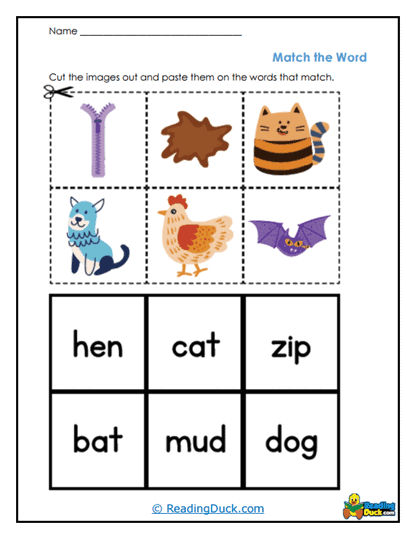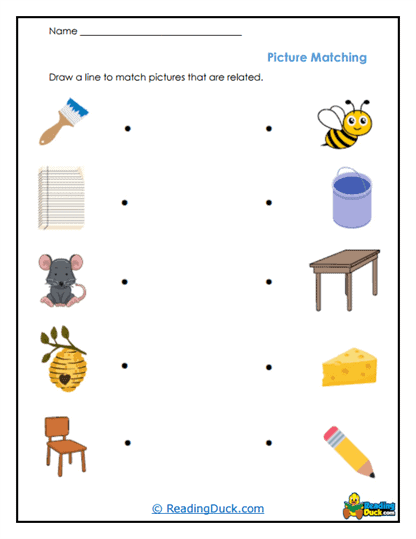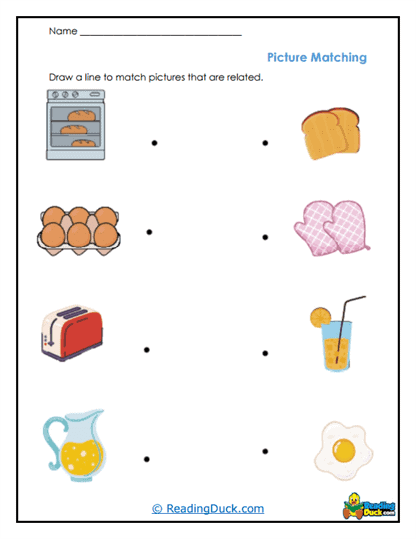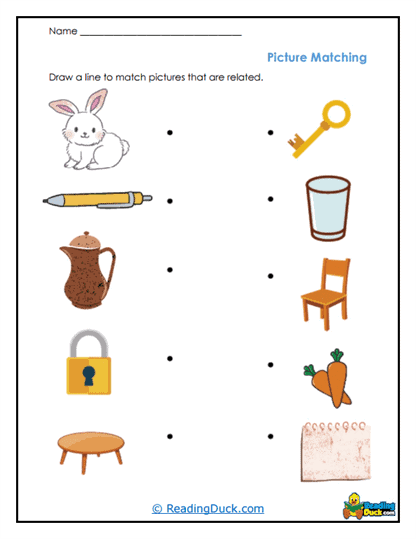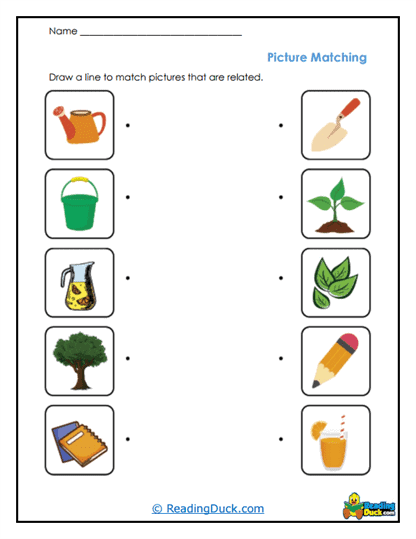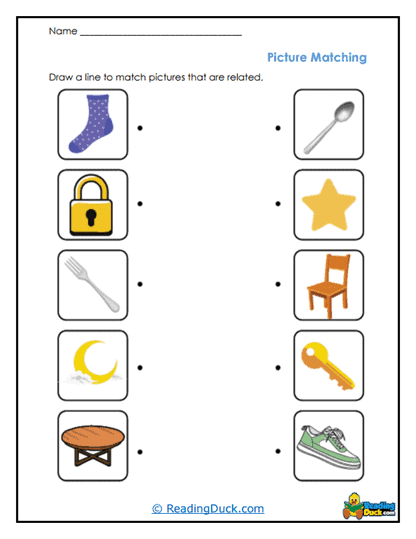Matching Related Pictures Worksheets
About Our Matching Related Pictures Worksheets
Our collection of Matching Related Pictures Worksheets offers an expansive range of engaging tasks designed to build essential pre-reading skills in young learners. These worksheets encourage children to identify and connect related pictures, fostering their ability to recognize relationships between different objects, concepts, and words. Each worksheet presents a fun yet educational challenge, where students might be asked to match a fish to its bowl, a bird to its nest, or a rain cloud to an umbrella. The variety of exercises—ranging from drawing lines to connect images, encircling the correct match, to interactive cut-and-paste activities—ensures that learners remain engaged and motivated.
These worksheets are available in a user-friendly PDF format, making them easily accessible for both electronic viewing and printing. This flexibility allows educators and parents to integrate these resources seamlessly into a variety of educational settings, whether in a traditional classroom, a homeschool environment, or as supplementary practice at home. The PDF format also ensures that the worksheets maintain their high quality when printed, making them suitable for repeated use.
The Educational Value of Matching Related Pictures
Matching related pictures serves as a foundational activity that plays a crucial role in early childhood education. This seemingly simple task is loaded with educational benefits that extend beyond just visual recognition. Here’s a detailed exploration of how this activity supports the cognitive and linguistic development of young learners:
- Vocabulary Expansion: One of the primary benefits of matching related pictures is vocabulary development. By connecting images like a bird and its nest, or a fish and its bowl, children are learning to associate words with their corresponding objects and concepts. This not only reinforces the meaning of individual words but also helps children understand how these words relate to each other in a broader context. Over time, this activity builds a robust vocabulary, which is fundamental to both reading comprehension and effective communication.
- Sentence Comprehension: Matching related pictures lays the groundwork for understanding sentence structure. For example, when a child matches a cloud with an umbrella, they are engaging in a form of visual storytelling that mirrors the construction of a sentence. This helps children grasp the concept of cause and effect, sequence, and logical relationships between ideas. As they develop this understanding, they become better equipped to comprehend more complex sentences and texts, which is essential for their reading development.
- Sentence Construction: Beyond comprehension, matching related pictures also aids in sentence construction. When children recognize the relationship between two images, they are, in essence, constructing a basic sentence in their minds. For example, they might think, "The cloud is related to the umbrella because the cloud brings rain, and the umbrella protects me from the rain." This cognitive process is the first step towards the ability to construct coherent sentences, which is a key skill in both oral and written communication.
- Cognitive Development and Analytical Skills: Matching related pictures requires children to engage in a higher level of thinking. They must analyze each picture, identify its key features, and determine how it relates to another image. This process enhances their cognitive abilities, including critical thinking, problem-solving, and logical reasoning. These skills are not only crucial for academic success but also for everyday decision-making and understanding the world around them.
- Fine Motor Skills and Hand-Eye Coordination: The physical act of matching—whether it’s drawing a line between two images, encircling the correct match, or cutting and pasting—requires precise movements that improve fine motor skills and hand-eye coordination. These activities help children develop the physical skills needed for writing, drawing, and other tasks that require dexterity and precision.
- Visual Literacy: In today’s image-rich world, visual literacy is an essential skill. Matching related pictures helps children develop the ability to interpret and understand visual information. By recognizing the connection between images, children learn to decode and make sense of visual cues, which is a critical aspect of reading comprehension and overall communication.
- Memory and Recall: Engaging in matching activities also strengthens memory and recall abilities. As children repeatedly engage with these worksheets, they start to remember the associations between different images. This repetition reinforces neural connections in the brain, leading to improved memory retention, which is crucial for all areas of learning.
Practical Tips for Incorporating Matching Related Pictures Worksheets
Matching Related Pictures Worksheets are a versatile tool that can be used in a variety of educational settings to support and enhance learning. Here are some practical ideas for integrating these worksheets into your teaching or homeschooling routine:
- Daily Literacy Centers: Incorporate these worksheets into daily literacy center activities. They are ideal for small group sessions where children can work together to solve the matching tasks. This collaborative approach not only reinforces the learning objectives but also encourages peer interaction and cooperative learning, which are important social skills.
- Morning Warm-Up Activities: Use these worksheets as a morning warm-up exercise to get students ready for the day’s lessons. This quick activity helps activate their brains and prepares them for more intensive learning tasks later in the day.
- Homework Assignments: These worksheets are perfect for homework assignments. They provide additional practice that reinforces the day’s lessons and helps parents stay engaged with their child’s learning process at home. Plus, they’re simple enough for young learners to complete independently, fostering a sense of responsibility and self-sufficiency.
- Intervention and Remediation: For students who may be struggling with vocabulary, sentence comprehension, or cognitive skills, these worksheets can be used as part of an intervention or remediation program. By providing targeted practice, you can help these students catch up with their peers and build the confidence they need to succeed.
- Homeschooling: These worksheets are an excellent resource for homeschooling parents looking to provide structured and effective literacy instruction. They can be integrated into a daily lesson plan or used as supplementary material to reinforce key concepts. The worksheets are particularly useful for one-on-one instruction, allowing parents to tailor the learning experience to their child’s specific needs.
- Differentiated Instruction: Teachers can use these worksheets to differentiate instruction, catering to the varying skill levels of their students. For more advanced learners, the matching activities can be made more challenging by increasing the complexity of the images or the relationships between them. For beginners, simpler worksheets can be used to build confidence and foundational skills.
- Grade Levels: These worksheets are most beneficial for Pre-K through 1st-grade students, aligning perfectly with the developmental stages of early literacy. However, they can also be adapted for use with older students who may need additional support in developing their reading and comprehension skills. Special education teachers may also find these worksheets valuable for students with learning disabilities or developmental delays.
The Long-Term Impact of Matching Related Pictures
Engaging in Matching Related Pictures Worksheets provides young learners with skills that extend far beyond the classroom. Here’s how this activity contributes to both academic success and personal growth:
- Laying the Foundation for Literacy: The skills developed through these worksheets form the cornerstone of early literacy. By understanding how words relate to objects and ideas, children build the foundation they need for reading and writing. This foundational knowledge is crucial as they progress to more complex texts and writing tasks in later grades.
- Fostering a Love of Learning: Successfully completing matching tasks gives children a sense of accomplishment and boosts their confidence. This positive reinforcement encourages them to engage more deeply with learning materials, fostering a lifelong love of learning that will benefit them throughout their academic career and beyond.
- Developing Effective Communication Skills: As children expand their vocabulary and improve their comprehension, they become more effective communicators. This ability to express themselves clearly and understand others is essential not only for academic success but also for social interactions and personal relationships.
- Building Critical Thinking and Problem-Solving Skills: The analytical skills honed through matching activities are critical for success in many areas of life. Whether it’s solving math problems, understanding scientific concepts, or navigating social situations, the ability to think critically and solve problems is invaluable.
- Supporting Emotional and Social Development: The confidence gained from mastering these worksheets can have a positive impact on a child’s emotional well-being. Children who feel successful and capable are more likely to take on challenges, engage with their peers, and develop a positive self-image. Additionally, activities that involve group work or discussions about the matching pairs can enhance social skills and foster a sense of community in the classroom.
- Nurturing Creativity and Imagination: Matching related pictures also taps into a child’s creativity and imagination. By exploring how different objects and ideas connect, children learn to think outside the box and see the world in new and interesting ways. This creative thinking is not only important for academic success but also for innovation and problem-solving in everyday life.
In conclusion, our Matching Related Pictures Worksheets are an essential tool for building the foundational skills that young learners need for academic success. By incorporating these worksheets into your teaching strategy, you’re not only helping students develop critical literacy skills but also supporting their overall cognitive, emotional, and social development. These worksheets are more than just a fun activity—they are a powerful educational resource that can make a significant difference in a child’s learning journey.
